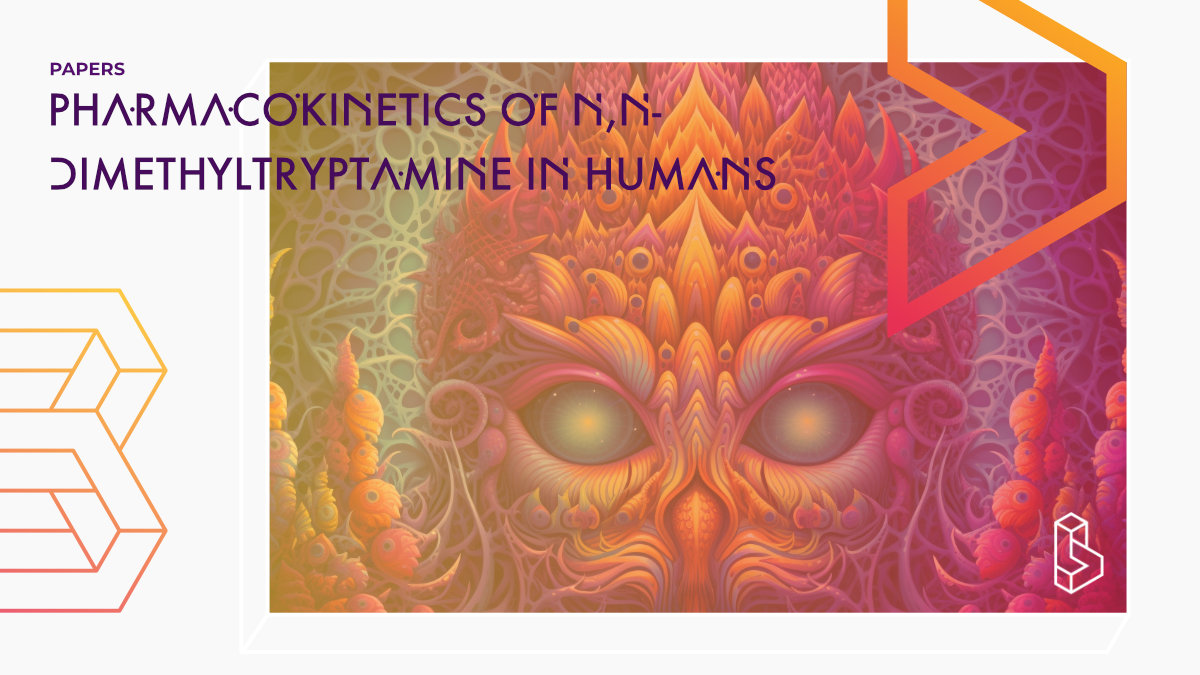This double-blind, placebo-controlled study (n=24) evaluated the metabolism and clinical pharmacokinetics (how the body processes drugs) of DMT (SPL026) in an ongoing Phase I study with healthy subjects by Small Pharma. Participants received escalating doses of SPL026 via a 2-phase intravenous (IV) infusion. SP206 was safe and well-tolerated, and dose-proportional increases in DMT exposure were observed over 9–21.5 mg. For all doses, the median time to peak plasma concentration was ~10 min, and the mean elimination half-life was 9–12 min.
Abstract of Pharmacokinetics of DMT in Humans
“Aim: N,N-dimethyltryptamine (DMT) is a psychedelic compound under development for the treatment of major depressive disorder (MDD). This study evaluated the in vitro metabolism and clinical pharmacokinetics (PK) of DMT fumarate (SPL026) in healthy subjects.
Methods: Results are from the Phase I component of an ongoing Phase I/IIa randomised, double-blind, placebo-controlled, parallel-group, dose-escalation trial. Healthy adults received escalating doses of SPL026 via a 2-phase intravenous (IV) infusion. Dosing regimens were calculated based on PK modelling and predictions, with progression to each subsequent dose level according to safety and tolerability. In vitro experiments assessed hepatic clearance and metabolism of DMT by monoamine oxidase (MAO) and cytochrome P450 enzymes.
Results: 24 healthy subjects received escalating doses of SPL026 which were safe and well-tolerated. Dose-proportional increases in DMT exposure were observed over the range of 9–21.5 mg. For all doses, the median time to peak plasma concentration was ~10 min and mean elimination half-life was 9–12 min. There was no relationship between peak DMT plasma concentration and body mass index, weight or age. In vitro hepatic mitochondrial fraction clearance of SPL026 was inhibited by MAO-A, but not MAO-B, inhibition. CYP2D6 and CYP2C19 modified SPL026 clearance in vitro. The unbound fraction of SPL026 was approximately 70%.
Conclusion: This is the first study to determine, in detail, the full PK profile of DMT in humans, confirming rapid attainment of peak plasma concentrations followed by accelerated clearance. These findings provide evidence which supports the development of novel DMT infusion regimens for the treatment of MDD.”
Authors: Meghan Good, Tiffanie Benway, Zelah Joel, Carol Routledge, Christopher Timmerman, David Erritzoe, Richard Weaver, Graham Allen, Charlotte Hughes, Helen Topping & Ellen James
Summary of Pharmacokinetics of DMT in Humans
Several clinical trials have supported using psychedelics to treat major depressive disorder. DMT, the principal psychedelic compound in the psychoactive plant brew ayahuasca, is orally bioavailable when administered with harmala alkaloid constituents.
DMT peak blood concentrations are reached at approximately 2 min, and psychedelic effects are apparent almost immediately and resolve within about 30 min. Plasma levels of DMT correlate with changes in brain activity and intensity of psychedelic experience.
The study aimed to investigate the pharmacokinetics (PK) and metabolism of DMT in humans, and to determine a safe and well-tolerated infusion dose of DMT to give to patients with MDD in a phase IIa clinical trial.
Find this paper
Pharmacokinetics of N,N-dimethyltryptamine in Humans
https://doi.org/10.22541/au.165237523.39763980/v1
Open Access | Google Scholar | Backup | 🕊
Cite this paper (APA)
Good, M., Joel, Z., Benway, T., Routledge, C., Timmermann, C., Erritzoe, D., ... & James, E. (2023). Pharmacokinetics of N, N-dimethyltryptamine in Humans. European Journal of Drug Metabolism and Pharmacokinetics, 1-17.
Study details
Compounds studied
DMT
Topics studied
Depression
Healthy Subjects
Study characteristics
Original
Placebo-Controlled
Double-Blind
Within-Subject
Randomized
Bio/Neuro
Participants
24
Humans
Authors
Authors associated with this publication with profiles on Blossom
Chris TimmermannChris Timmerman is a postdoc at Imperial College London. His research is mostly focussed on DMT.
David Erritzoe
David Erritzoe is the clinical director of the Centre for Psychedelic Research at Imperial College London. His work focuses on brain imaging (PET/(f)MRI).
Institutes
Institutes associated with this publication
Small PharmaSmall Pharma works on the development of two drugs. Together with Imperial College London they are developing intravenous administration DMT. The other project is a variant on ketamine (SPL801B).
Imperial College London
The Centre for Psychedelic Research studies the action (in the brain) and clinical use of psychedelics, with a focus on depression.
Compound Details
The psychedelics given at which dose and how many times
DMT 9 - 21mg | 1x
Linked Research Papers
Notable research papers that build on or are influenced by this paper
Safety, tolerability, pharmacodynamic and wellbeing effects of SPL026 (dimethyltryptamine fumarate) in healthy participants: a randomized, placebo-controlled phase 1 trialThis Phase I study (n=44) investigates the safety, tolerability, pharmacokinetics, and -dynamic profile of escalating doses of SPL026 (DMT fumarate; 9-21.5mg) in psychedelic-naïve healthy participants. The RCT concludes that SPL026 was well-tolerated, showing an acceptable safety profile, with potential correlations between plasma concentration and psychometric measures.
Linked Clinical Trial
SPL026 (DMT Fumarate) in Healthy Subjects and MDD PatientsSPL026 (N,N-dimethyltryptamine [DMT] fumarate) is a psychedelic tryptamine being developed as a therapy for patients with major depressive disorder (MDD).
